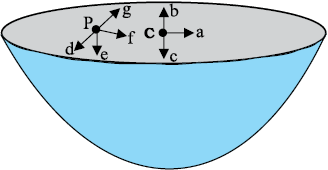Choose the correct alternative.
| 1. | Acceleration due to gravity increases with increasing altitude. |
| 2. | Acceleration due to gravity remains unchanged with increasing altitude. |
| 3. | Acceleration due to gravity increases with increasing depth (assume the earth to be a sphere of uniform density). |
| 4. | Acceleration due to gravity decreases with increasing depth (assume the earth to be a sphere of uniform density). |
Acceleration due to gravity is:
| 1. | independent of the mass of the earth. |
| 2. | independent of the mass of the body. |
| 3. | independent of both the mass of the earth and the body. |
| 4. | dependent on both the mass of the earth and the body. |
Suppose there existed a planet that went around the sun twice as fast as the Earth. Then its orbital size as compared to that of the Earth would be:
| 1. | \(0.63\) times greater than that of Earth. |
| 2. | \(0.73\) times smaller than that of Earth. |
| 3. | \(0.63\) times smaller than that of Earth. |
| 4. | \(0.73\) times greater than that of Earth. |
One of the satellites of Jupiter has an orbital period of \(1.769\) days and the radius of the orbit is \(4.22 \times 10^{8}\) m. The ratio of the mass of Jupiter and the mass of the sun nearly is: (Mass of the sun \(\approx 2\times 10^{30}~\text{kg}\))
1. \(1000:1\)
2. \(1:1000\)
3. \(1:1\)
4. \(2000:3\)
Choose the correct alternative.
| 1. | If the zero of potential energy is at infinity, the total energy of an orbiting satellite is negative of its kinetic energy. |
| 2. | If the zero of potential energy is at infinity, the total energy of an orbiting satellite is negative of its potential energy. |
| 3. | The energy required to launch an orbiting satellite out of earth’s gravitational influence is more than the energy required to project a stationary object at the same height (as the satellite) out of earth’s influence. |
| 4. | Both (1) and (3) are correct. |
Let us assume that our galaxy consists of 2.5 × stars each of one solar mass. How long will a star at a distance of 50,000 ly from the galactic centre take to complete one revolution? (The diameter of the milky way is ly.)
1. 3.55 × 108 years
2. 4.55 × 108 years
3. 3.55 × 107 years
4. 4.55 × 107 years
The escape speed of a body from the Earth depends on:
| 1. | the mass of the body. |
| 2. | the location from where it is projected. |
| 3. | the direction of projection. |
| 4. | the height of the location from where the body is launched. |
A comet orbits the sun in a highly elliptical orbit. The comet has a constant:
1. linear speed
2. angular speed
3. angular momentum
4. kinetic energy
Which of the following symptoms is not likely to afflict an astronaut in space?
1. swollen feet
2. swollen face
3. headache
4. orientational problem
The gravitational intensity at the centre of a hemispherical shell of uniform mass density has the direction indicated by the arrow:

1. a, d
2. b, d
3. c, e
4. d, e






